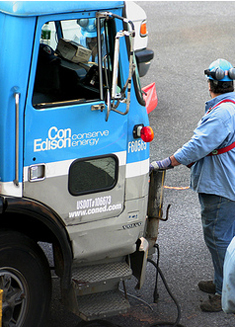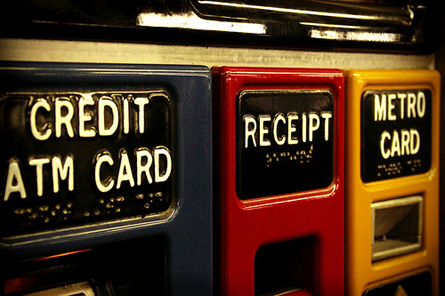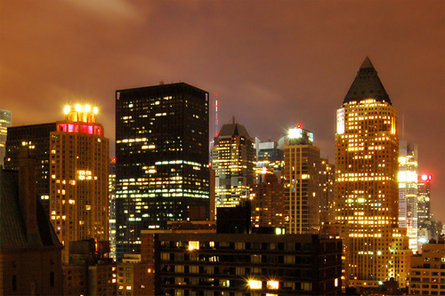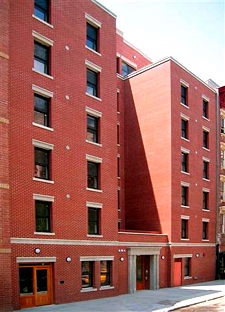Paying the Price for Living in New York

It was another $52 worth of groceries for Vann Williams and another four days of food on the table in his East Village apartment. A born and bred New Yorker, Williams, 48, has become accustomed to dealing with ever-rising expenses.
"I have to watch every cent," he said with an armful of groceries outside of the Key Food near his home. "The cost of living has grown tremendously."
Over his nearly three decades in Manhattan, Williams, a gardener for the city's Department of Parks and Recreation, said he has seen his grocery costs nearly double, his utility rates climb and the cost of a subway ride quadruple.
This leaves Williams, like many other New Yorkers, facing tough choices: get a roommate, skip a night out, move to the outer boroughs or to the suburbs. After all, you can't fight inflation.
For many reasons, groceries, utilities and other necessities cost more in New York than elsewhere in the country. And the situation promises to get worse. Consolidated Edison has proposed a 17 percent rate hike for residential customers, the New York Water Board approved a nearly 12 percent water rate increase and is considering upping that another 18 percent, and in December the Metropolitan Transportation Authority is expected to vote on a revenue producing proposal, which almost certainly will mean another fare increase.
Wages Stall as Costs Climb
Some city dwellers, including Mayor Michael Bloomberg, contend New York is more expensive, because it is a better place to live. The earth shattering rents, skyrocketing electricity bills and $2 subway fare are all worth it for the culture, the diversity, the food and the excitement.
It is easy for a billionaire like Bloomberg to feel that way. For other New Yorkers, though, that outlook has become more and more difficult to keep.
To put things into context, a lot of New Yorkers, particularly in Manhattan, have high salaries that buffer them against the steep cost of living. According to data released last week by the Bureau of Labor Statistics, New York County has the highest weekly wage of any large county in the country. (These figures do not factor in the unemployed, self employed, domestic workers and others). While the average national wage in the first quarter of 2007 was $885, Manhattan residents average $2,821 a week, nearly $1,000 more than citizens of the runner up area - Fairfield, Connecticut, with $1,979.
For the middle or low-income New Yorker, the rising cost of living may not be as easy to bear. For instance, the weekly wage was below the national average at $788 in Bronx County, where residents must grapple with the same citywide rate increases as their far more affluent counterparts in Manhattan.
According to a report released by the Fiscal Policy Institute last month, the wage for professional occupations and high-end earners increased steadily from 2000 through 2006 statewide, but those on the lower end of the salary totem pole have seen their earnings stagnate. While some who hold lucrative jobs on Wall Street hardly flinch at the possibility of an upcoming subway fare increase or Con Ed rate hike, for low income New Yorkers the slightest rise can mean added expenses that they just cannot afford.
"Even now, with the increase they're speaking of, it adds another $10 to $15," said Williams of Con Edison's recent rate proposal.
Gary La Barbera, president of the New York City Central Labor Council, said wages and benefits have not kept pace with the rising cost of living, despite low unemployment records. He calls the current situation "underemployment," as mothers and fathers work two or three jobs to make ends meet.
"Most workers have relatively little to show in wage and income gains," said La Barbera. "Rising costs are clobbering paychecks."
Comparing Urban Areas
The Consumer Price Index – a measure of how much the cost of a "basket" of items, from housing to food, has changed over time – has not shown steep monthly increases for the New York metropolitan area recently. A 20-year view, though shows that prices here often outpace those in the rest of the country.
Data released last week by the Bureau of Labor Statistics reveal the Consumer Price Index grew by 2.4 percent since September 2006 – an increase that shows "relatively little movement" in the past several months. Nationwide, the index increased 2.8 percent from September 2006, due to higher costs for housing, food and, of course, energy.
Since 1987, however, the consumer price index for New York has grown by 90.6 percent, according to the Bureau of Labor Statistics, an increase that is fueled mostly by the rising cost of housing. In other somewhat comparable areas, like Los Angeles, the index increased by 84.5 percent. In Cleveland, the index jumped only 71.8 percent in those two decades. From 2000 through 2006, New York metropolitan consumer prices have risen over 20 percent faster than U.S. costs, according to the Fiscal Policy Institute.
The increases here indicate that housing reigns supreme. Housing in the area jumped 106.4 percent since 1987, while in Chicago it increased 77.2 percent and in Boston 95.4 percent over the same time period.
"New York being a more expensive place to live has been true since Peter Stuyvesant got here," said Lawrence White, a professor at New York University's Leonard N. Stern School of Business. "The heart of what makes that so is that it's all about land. There is a limited amount of Manhattan and everybody wants to be there."
That cost can trickle into other increases for New York consumers. The high rent that businesses pay may translate into a more expensive hamburger or a pricier visit to your primary care physician.
Energy
 Like housing, energy is a major factor in the city's cost of living. And, like housing, energy costs reverberate through myriad industries – consider heating your home, buying gas for your car and even the price of clothing.
Like housing, energy is a major factor in the city's cost of living. And, like housing, energy costs reverberate through myriad industries – consider heating your home, buying gas for your car and even the price of clothing.
Electricity prices here have increased 2.4 percent from a year ago, according to the Consumer Price Index. That is a measure of inflation and is unrelated to the rate increase proposed by Con Edison.
"Energy costs are going up across the country," said White. "That means that gasoline prices are going to be affected. That means electricity prices are going to be affected."
According to Con Edison Spokesman Michael Clendenin, the utility simply passes its own increases on to consumers. "You pay what we pay," said Clendenin of purchasing electricity. "The rate increases are not tied to inflation. Rate increases happen because we have to build more, invest more and put more infrastructure on the ground."
Con Edison's most recent rate increase proposal – the utility is seeking a 17 percent increase for residential customers and a 10.7 percent increase for commercial customers to take effect next year – is needed to meet the city's increasing demand as well as make much-needed infrastructure improvements, according to a press release. The average customer, who pays about $70 a month, would have to pay an extra $12. Already, according to some estimates, New Yorkers pay the highest rates in the country.
"You're dealing with infrastructure that is so old and obviously going to wear out soon," said David Blackshire, a musician on the Lower East Side, of the rate increase proposal. "But they really don't give people much back for their money."
Blackshire is not alone in this perception that the utility does not deserve a rate hike. City officials question the utility's ability to consistently provide quality service given its recent history, which includes this summer's steam pipe explosion and last summer's blackout.
State and local officials are gearing up to fight the hike over the next several weeks. Currently, the proposal is in public hearings before the state's utility regulator – the Public Service Commission. Just last week, the City Council decided to become an active party in the rate debate.
Economoist said there is a good reason that Con Edison charges more than many other utilities. Urban environments are subject to wear and tear at a faster rate than suburban areas, so infrastructure repairs are both more costly and more frequent.
"Our utilities are more expensive because Con Ed has greater expenses in dealing with an urban grid," said White. "Something goes wrong and its takes longer to maintain it and fix it."
Water Rates
When the New York Water Board, part of the city's Department of Environmental Protection, raised rates by 11.5 percent in May, it attributed the hike to increased energy costs and a backlog of unpaid water bills. That increase, the largest in 15 years, added approximately $72 to the average annual water bill – now estimated at nearly $700 for residential customers.
And now, the board is reportedly thinking about hiking rates again. Because so many corporations and residents have failed to pay their bills , the agency could be short $200 million by the end of this year. To make up for the loss, it is eyeing an additional 18 percent increase.
The water board, established in the 1980s, has long had a so-called delinquent billing system, critics say. Because it was seen as unfair to shut off residents' faucet when their landlord did not pay the water bill, the department continued to provide water without compensation. Although the department is now warning companies and residences that it could cut off service, according to some estimates, that may not be enough to avoid a budget shortfall. Several city officials, including Queens City Council members James Gennaro and David Weprin, are urging the department to fix its broken billing system and redirect its funding toward water and sewer projects.
The board is expected to monitor bills this month, and then meet in November to determine whether another hike is needed. Any increase could come as soon as January.
Subway Fares
In addition to water and electricity rate hikes, New Yorkers should also brace for an increase in public transportation fares. To address a looming budget deficit, the Metropolitan Transportation Authority is considering two proposals that would boost fares. One proposal boosts fares, while incorporating discounts for travel at off-peak hours. Both proposals consider a standard fare increase of 25 cents. New Yorkers who rely on the subway to get to and from work every day could see their monthly unlimited pass increase by 8 percent.
While any proposed fare hike attracts opposition, some economists argue that public transportation is relatively cheap in New York City.

"One thing that’s potentially cheaper is transportation," said Nicole Gelinas, a senior fellow at the Manhattan Institute. "The price for a subway ride has historically not kept up with inflation."
According to the Bureau of Labor Statistics, the New York metropolitan area's transportation costs have increased by 72 percent since 1987. Cleveland, for example, has seen an 81.4 percent increase.
Groceries and Restaurants
The cost of living is also on the rise, according to the Consumer Price Index, because of rising food costs. Nationwide, dairy prices have increased 13.1 percent in the last year. Prices for groceries have increased 4.7 percent in the past year, while food purchased in restaurants has gone up 4.1 percent.
The Bureau of Labor Statistics does not keep regional or area food costs. And while there could be slight variation from area to area, for the most part food prices in this area remain equivalent to those nationwide, according to Martin Kohli of the bureau's New York office.
This most recent increase, Kohli said, is due to a higher demand for corn and wheat products as a source of energy for ethanol as well as for food. Whether this trend will persist, he added, remains to be seen. Other food price increases could be attributed to higher trucking costs, which brings us back to the cost of energy, he said.
Economists agreed that the slight variation that can arise in food prices here compared to the rest of the country might also end up going back to the cost of housing.
 "Clearly there is no conspiracy of American farmers to charge New Yorkers more," said Frank Braconi, chief economist at the city comptroller's office. "If you have food prices going faster, in all likelihood it's going to come back to real estate one way or another ... supermarkets competing for space."
"Clearly there is no conspiracy of American farmers to charge New Yorkers more," said Frank Braconi, chief economist at the city comptroller's office. "If you have food prices going faster, in all likelihood it's going to come back to real estate one way or another ... supermarkets competing for space."
For example, a loaf of white bread may cost you $2.17 in Manhattan, but it will cost you $1.74 in San Francisco and $1.68 in Queens, according to a cost of living index compiled by the Council for Community and Economic Research – a national economic research group.
A half-gallon carton of whole milk, however, is more expensive on the West Coast: It costs $2.06 in Manhattan, and just $1.70 in Queens versus $2.53 in San Francisco, according to the council. Kohli said dairy products, which are produced regionally, tend to have more variation in price.
Restaurants also see the effects of inflation. According to the National Restaurant Association, between July 2006 and July 2007, wholesale food prices increased 7.5 percent. If this trend continues, it will represent the highest food price increase in 27 years, the association said. That has translated into a 3.6 increase in menu prices over the year, according to the association.
East Village resident Jonathan Mclaughlin has seen the smaller, and cheaper restaurants in his neighborhood raise their menu prices recently. That all affects his ability to keep up with the cost of living in New York City.
"You go Mexican it would be $10," said Mclaughlinm who chose to buy Boca Burgers instead of eating out on a recent evening. "Now it's $15."
What Can Be Done
While city government is limited in what it can do to stave off rising costs for New Yorkers, economists and advocates point to several areas where it could help keep prices down.
Advocates like Tracy Shelton, a consumer attorney with the New York Public Interest Research Group, say better government regulation and oversight can reign in costs such as water and electricity rates. Overseeing utility companies should be a high priority, she added.
"They need to be looked at very, very carefully - if they are going to offer people life and death services - so the infrastructure doesn’t age out to the point where we have horrible blackouts in the middle of heat waves," said Shelton of utility service providers.
Gelinas of the Manhattan Institute said officials should not have a "knee-jerk" reaction to the construction of more power plants in the area, which would ultimately drive down costs and better supply the region. More regulations, she added, will not necessarily create lower costs.
Although some residents, including Williams, have considered leaving the city for more affordable pastures, the Big Apple will continue to draw people in, ironically, for the very reasons that make it an expensive place to live.
"If I do have to go," said Williams, "I'd hate to leave."
Â
Cleaning Up New York's Buildings

When Mayor Michael Bloomberg visited London earlier this month to talk with Mayor Ken Livingstone about that city’s congestion plan, he slept in his own bed in the 3,500 square-foot apartment he owns in London’s exclusive Cadogan Square neighborhood. He told reporters that in New York he lives simply and efficiently – in a 7,500 square foot Upper East Side townhouse. “I get my haircut two doors away,” Bloomberg told a reporter from the International Herald Tribune. “I never have to leave the neighborhood.”
He can afford not to. But even staying home can take a toll on the environment – as the mayor’s own environmental plan makes clear.
The streams of traffic crashing against the city’s various choke points may be New York’s most iconic image of waste and pollution. But, in fact, the city’s buildings – its defining physical elements – account for the bulk of New York’s energy use and carbon emissions. The city’s 750,000 buildings – residential, commercial and government -- are responsible for nearly 80 percent, or 47 million metric tons, of New York City’s total carbon dioxide output. That’s the equivalent of 150 Empire State Buildings worth of greenhouse gas being pumped annually into the atmosphere – hanging heavily over its economy, landscape and environment.
Buildings in the city’s commercial sector, alone, which includes offices and retail space, kick out 25 percent of all emissions (transportation, by contrast, accounts for 23 percent).
Despite this, Bloomberg’s ambitious PlaNYC2030 is largely silent on reducing pollution from buildings other than those built or owned by the city. It says virtually nothing about commercial buildings. Can New York City expect to meet its goal of reducing overall emissions by 30 percent by 2030 if it does not move aggressively – like London – to encourage and, in certain cases, impose efficiency standards on commercial property, one of its largest polluting sectors? Or will the combination of market forces and moral responsibility prove powerful enough to bring the city’s business leaders in line with the city’s push for sustainability?
Polluting Buildings
Though the world’s largest cities account for 2 percent of land area, they generate 75 percent of the world’s carbon emissions. Despite that, New York already fares well on some measures of efficiency and sustainability. PlaNYC acknowledges as much. “Our density, apartment buildings and reliance on mass transit means we are one of the most carbon-efficient cities in the United States,” the plan states. “New Yorkers produce 71 percent less carbon dioxide per capita than the average American.” (Carbon dioxide emissions are the key cause of global warming.)
To take a page from Bloomberg’s playbook we can look at London and its sprawling metropolitan area with a mĂ©lange of aging and new buildings and a population of 7.5 million. There, buildings account for an almost identical proportion of energy use, according to a statement by London deputy mayor Nicky Gavron.
The two cities not only have similar demographics and man-made environments, they have recently begun reckoning with their obligation to make those built environments more sustainable. Two months before Bloomberg and his Office of Long Term Planning and Sustainability rolled out PlaNYC 2030, London’s Mayor Ken Livingstone released his own 148-page report called the Climate Change Action Plan. The two documents are strikingly similar in approach and have been applauded by environmental and business leaders alike. Each plan outlines key sources of energy use and carbon emissions and presents an array of policy proposals for each of the cities as they reckon with a future marked by increasing populations, rising costs of living and warming temperatures.
Yet there is at least one conspicuous – and significant – difference between the London and New York reports. The London plan devotes a full section to commercial and institutional buildings – analyzing in minute detail their energy use, recommending ways to improve efficiency and outlining various regulatory measures intended to force the commercial sector’s hand. New York City’s report, however, has no such section.
Bloomberg’s report does offer an exciting yet jarring portrait of New York City two decades from now: an influx of a million people, the creation of 750,000 new jobs, the construction of 265,000 new housing units and 60 million square feet (more than four former World Trade Centers) of new commercial space. Despite the new construction, existing buildings will account for 85 percent of the buildings standing in New York City in 2030, according to deputy mayor for economic development Dan Doctoroff.
Buildings pollute in a number of ways. Most building pollution, however, does not emanate from the residences and offices themselves but the smokestack of a power plant when a light switch, computer monitor or coffee maker is switched on. Various emissions are also generated on-site from natural gas and oil-burning boilers, gas stoves and hot water heaters and the gasses released in the breakdown of certain building materials such as paint and insulation.
To address this, plaNYC calls for making the buildings we already have more efficient. “If we’re concerned about energy efficiency and carbon we need to start with buildings that have the largest carbon footprints,” said Rohit Aggarwala, director of the city's Office of Long Term Planning and Sustainability. “As a city I’d like to see us prioritize those retrofits and projects that have the biggest bang for the buck.”
Improving What We Have
|
The Diversity Houses |
Reducing energy use and carbon emissions is architect Chris Benedict’s goal as well. Benedict, who has headed her own firm since 1996 and teaches environmental technology at the Parsons School of Design, has a number of rehabilitation projects, including one at a residential building on West 126th Street in Harlem. Benedict says she is achieving energy savings in the range of 50 percent in her renovations and that her new buildings are achieving a rate of efficiency 80 percent greater than “average” buildings. And she says she’s doing it at no extra cost.
On a recent morning she is running a plastic cylinder into small boreholes made in the walls, extracting insulation and testing its density on a small digital scale. This lets her make sure that the amount of insulation blown into the walls is adequate for maximum efficiency – not the kind of work you typically find an architect engaged in, let alone early on a Saturday morning. But it’s the “magic” that makes efficiency happen, says Benedict.
Her prescriptions are elegantly simple – but require care in execution. Efficient buildings, she says, must be carefully designed to make sure air moves efficiently throughout. The key in this small apartment is making it airtight except in places where drafts are wanted – in this case, through trickle valves (small one-way vents activated by fans) installed in the high-performance windows. The fans push hot air out, allowing it to be replaced by cool air streaming in through the vents. In order for the system to work properly, a “bubble” must be established: All joints and cracks throughout the apartment must be meticulously sealed. The apartment’s efficient heating system relies on multiple thermostats that are able to regulate temperature room-by-room.
Other “simple” prescriptions include high efficiency appliances and green building materials such as recycled cellulose insulation and dimmers. Benedict says that for this reason it’s vital that work be carried out to the standards set forth in her plans. “We make the contractors working on our projects sign off that they will commit to following the plans exactly,” says Benedict. “If they don’t, none of this works.”
As reasonable as many of these improvements appear, the stark economics facing the city’s residents could limit the use of such improvements and make it difficult for the city to achieve further gains in residential efficiency. In 2004, more than 45 percent of renters – accounting for roughly a third of all households in the city – paid over 30 percent of their income toward housing. The price of real estate continues to gallop away from wages. While the average house price sits at $550,000 (in Manhattan, the average is $1.3 million) the average income hovers around $40,000. Such statistics paint a gloomy picture – one of strapped renters and homeowners with little free cash to invest in efficiency upgrades.
Projects such as the well-known luxury apartment building, the Solaire, which boasts photovoltaic cells and a green roof garden and where three-bedroom apartments are pushing $5,000 a month, inevitably raise the issue of whether efficiency can be affordable. Benedict says that there is no reason why it can't be.
And builders seem to be catching on. A number of efficient projects intended for low- and moderate-income families are popping up around the city. These include Via Verde in the South Bronx, the Ocean Hill-Brownsville Complex in Brooklyn and the Diversity Houses on East 2nd and 3rd Streets in Manhattan (another one of Benedict’s projects).
The administration hopes that projects such as these will encourage others. PlaNYC, though, does not set specific rules for increased efficiency in New York City’s homes and apartments.
Efficiency in Government
For its own buildings, though, the city has made some headway in promoting wide-scale building efficiency. With the recent passage of Green Buildings Act (in .pdf), the city’s code now sets more stringent efficiency guidelines for municipal buildings. For example, capital projects costing (with the exception of schools, which are held to less rigorous standards) $30 million or more must reduce energy consumption by at least 25 percent. According to Aggarwala, next summer the city will introduce even more energy efficient measures for city buildings. He also says the Department of Buildings has stepped up enforcement of the state energy code to ensure that developers do not cut corners during construction.
|
The Hearst Building |
Aggarwala said, by 2015, he would like to see rules requiring all buildings over 100,000 square feet to have an energy audit. This would provide the city an overview on the performance of all its buildings, he says. But little has been done to force the commercial sector to adopt the stringent building codes embodied in the Green Buildings Act. “Our plan is less prescriptive than London’s. We don’t have the authority to regulate, say, what kinds of computers are used in the city,” he said.
The commercial sector has made some eye-popping gestures toward efficiency. New projects like the Hearst Tower, 1 Bryant Park and the new New York Times Building in Midtown jut skyward with massive dimensions – and promises. The 600-foot tall Hearst Tower boasts energy-saving measures such as high efficiency heating and cooling, motion sensors that regulate power usage and “Icefall,” a three-story waterfall driven by “harvested” rainwater, which helps humidify and cool the building’s open atrium. In all, its cutting edge features will reportedly make the building 22 percent more efficient than other office buildings.
Still, 22 percent is a far cry from Benedict’s 80 percent. Moreover, that figure does not factor in the energy costs of demolition, site clearing and rebuilding, which one Canadian study found required more than two and half times as much energy as rehabilitating an existing building.
Some developers have tried rehabilitating office space, though such projects are fairly unusual. In the 1990s, the National Audubon Society renovated the Schermerhorn Building in lower Broadway to create an energy efficient and generally environmentally friendly headquarters for the organization.
Audubon, of course, is a non-profit. For big corporations, new high-profile projects seem to be the preferred way to go – if they consider sustainability at all.
“There are some visionary, innovative and hopefully high performing commercial buildings going up here and there,” said Nancy Anderson, executive director of the Sallan Foundation, a non-profit that looks at urban sustainability. However, Anderson said a large number of buildings erected during New York City’s decade-long construction boom do not meet the highest efficiency standards. “We’re not going to where we have to go to in terms of our carbon dioxide reduction goals with a building here and there. We need to quickly achieve a scale – of many large numbers of buildings plus new buildings and renovations.”
Cheap Energy and Lots of It
Along with the many technical obstacles to increased efficiency in commercial buildings lies a more fundamental issue: economics. Even though energy is as costly as it has ever been, it is still cheap when compared with the other costs associated with building operations in New York City.
“ In our region, commercial building utility costs typically run at $3 to $5 a square foot. Overall operating costs in New York City run in the area of $30 to $50 a square foot. And rents in Midtown Manhattan are pushing $100 a square foot,” says Michael Bobker, a senior fellow at the CUNY Institute of Urban Systems. “So there you can see where energy fits into the overall economics of operating a building.”

Chris Benedict
Bobker, who is currently working with companies to develop environmentally friendly vision statements and integrated efficiency training programs, said, though, that there is reason to be optimistic. He sees movement for efficiency at the highest levels of the city’s commercial establishment. It is spurred, he said, more by ideology than money.
“ We’ve had price drivers for a long time and that hasn’t really driven the message the way we’re seeing it happening in the marketplace today,” says Bobker. “What’s different is that people are aware now that energy use is linked to climate change – and that’s what’s driving executives. It’s no longer just an economic issue. It’s an ethical issue.”
How far does that concern go? In business, the bottom line will always be ideology number one. Companies will balk at environmental regulations if they impose excessive construction costs, said Stephen Hammer, director of Columbia University’s Urban Energy Project. “Businesses say, New York City is already 25 percent more expensive than across the river and in Westchester. If you’re going to make us do all these extra things, construction costs are going to go up, and we’re going to leave.“
That kind of thinking is outmoded, said Hammer, because energy efficiency is vital to a firm’s long-term competitiveness in a global marketplace. What’s more, it can be profitable. London, Hammer said, shows us that environmental mandates can actually spur economic growth. In spite of Mayor Ken Livingstone’s uncompromising approach to efficiency mandates, London’s economy has grown steadily since his election in 2000. One prestigious magazine (albeit an English one), The Economist, has gone so far as to declare London the world’s new financial capital.
A tough love approach on efficiency, said Hammer, might be just what New York’s private sector needs to see the potential long-term savings of green building. “[London’s] businesses are finding that they can do this stuff without breaking the bank,” said Hammer. “In fact, they’re going beyond the mandates and finding that there’s economic reason to do it – that the return is good on efficiency.”
Jeremy Miller is a New Jersey-based freelance writer, who writes about people, science and the environment. His most recent work has appeared in The Boston Globe and The Boston Globe Sunday Magazine. Â
Burial Ground Bears Witness to a Segregated City
After 16 years of planning, research, excavation and development, New Yorkers recently celebrated the opening of the African Burial Ground Memorial in lower Manhattan. Speakers including poet Maya Angelou and Mayor Michael Bloomberg recognized the significance of remembering the long-forgotten burial site where some 15,000 to 20,000 people were interred. Remains from the burial site were uncovered in 1991 during construction of the federal office building on Duane Street and Broadway. A portion of the site is now a National Historic Landmark and National Monument.
But while Bloomberg acknowledged that “for two centuries slavery was widespread in New York City,” the ceremony and the flurry of press reports about it seemed to treat the burial site only as a reminder of past injustice and not as an opportunity to understand and reflect on the powerful historical connections to the present. Put in its true context, the burial grounds serves as a reminder of the powerful role that real estate has always played in displacing African Americans.
How The Burial Grounds Were Created
During the period of Dutch and English settlement, New York City was one of the nation’s largest urban centers for the slave trade and served as a financial patron of the plantation economy in the South. The city also had a sizeable population of slaves and freed blacks in New York City. In the Dutch colony, as many as 40 percent of the population were slaves.
Slaves had no choice of residence and were themselves treated like a commodity, first displaced from their homes in Africa and then traded in a public marketplace at the foot of Wall Street. But even freed blacks found their options limited by official and unofficial discrimination and by changes in the city. When land values and rents went up in the more populated areas of lower Manhattan, blacks were forced to find housing uptown. They kept being pushed uptown in successive waves until the formation of black Harlem. Those who could afford to buy property were often forced to seek land outside Manhattan in settlements like Weeksville, Brooklyn. This constant displacement, experienced in different ways by all people of modest means including many immigrant groups, was especially onerous for black people because discrimination in the real estate market limited their choices.
The African Burial Grounds in lower Manhattan were a result of this displacement process and associated discrimination. At the end of the 17th century, Trinity Church formally banned blacks from its cemetery in lower Manhattan as land in the fortified city became scarce. This led to the creation of the African burial grounds outside the walls of the old city.
By the end of the 18th century, however, the city had expanded beyond the walls and the African burial ground became desirable real estate. It was filled and leveled and then sold by the property owners. Given the exclusion of blacks from government, the public sector was blind to the importance that African culture places on the remembrance of ancestors, including the places where they lived and are buried.
Black Displacement and the Segregated City
The official barriers to racial equality in the city were removed in stages, but “enlightened” New York wasn’t far ahead of the South. In 1827, slavery was abolished in New York State, but until 1854 blacks were banned from “whites-only” streetcars. The Draft Riots of 1863, and other white-led race riots in 1900, targeted black communities and contributed further to their displacement.
In the 20th century, the federal urban renewal program resulted in the destruction of many black and mixed communities, leading to its being dubbed “Negro removal.” At the same time, federal mortgage guarantees did not apply in black neighborhoods. Thus blacks who were forced to move would not have the many options available to other groups. And the neighborhoods, and burial grounds, they left behind were quickly swept away.
Now, displacement of black communities continues to be complicated by the limited choices available, resulting in constant resegregation. In studies of racial segregation, New York consistently comes out as among the most divided cities. While new immigrant communities tend to be more diverse, the black/white divide in New York remains prominent, as revealed in a recent study. Real estate agents steer blacks away from mixed neighborhoods in many subtle ways and whites away from neighborhoods where blacks are moving in (this is known as blockbusting). Gentrification of traditionally black neighborhoods prices people out of the areas they have worked for generations to improve. Are No Sites Sacred?
As blacks have been forced out of communities the neighborhoods, and burial grounds, they left behind were quickly swept away. New York’s African Burial Ground provides a vivid example of this.
The similarities and differences between the official responses to rebuilding the World Trade Center site and to the African Burial Ground provide some perspective on this. After 9/11, Governor George Pataki led the pack of officials calling for a rapid restoration of the 13 million square feet of office space at Ground Zero. There was ample support for this in the media and among the city’s powerful real estate community. The Real Estate Board of New York declared: “We know it is important that downtown remain and grow as a powerful engine of the city’s, region’s and nation’s economies. The best living memorial to those who perished in the World Trade Center attack is to make sure that lower Manhattan emerges from this tragedy as a spectacular center of the global economy.”
The survivors’ families did not agree. Their powerful, organized voices led the state to scrap its original plans to rebuild Ground Zero without a memorial. The families formed multiple organizations, and while some demanded (with support from former mayor Rudolph Giuliani) that the entire site remain open and dedicated as a memorial to 9/11, they all insisted that there had to be a significant memorial. The use of the footprints of the two World Trade Center towers for that purpose eventually became a part of the final plan.
The Ground Zero story may illustrate the powerful role of real estate interests to retain prime office space. But it also demonstrates how that role can be limited when people organize and find powerful patrons in government.
In the case of the African Burial Ground, African American groups faced initial resistance from the federal government. It took a good deal of active organizing by the groups to push for development of the memorial, and the process dragged on for 16 years. Most amazing, however, is the fairly limited size of the memorial footprint. The federal government never seriously considered canceling its office tower project for a more prominent memorial. Construction of the federal building was hardly delayed, and it now casts a long shadow over the moving “Ancestral Libation Chamber.” Despite the National Park Service’s quality programming for the site, it is easy to lose sight of this treasure among the shadows of downtown towers.
This seems to be part of a larger pattern. This city, which has always had a sizeable African American population, has a disproportionately small number of historic landmarks in African American communities. In part this is a result of the traditional emphasis in preservation circles on noble buildings by star architects (of European descent) and the resistance by traditional preservationists to preserving places as memorials to important historical events and cultural practices. (A good antidote to this thinking is Place Matters.) Beyond that, though, it appears that every memorial site in the Big Apple needs vocal advocates to balance the powerful pull of the real estate industry.
• • • • •
Land Use readers may be interested in the recently released community plan for the Vanderbilt Yards, an alternative to Forest City Ratner’s stalled megaproject. Go to www.unityplan.orgfor information and press reports.
Tom Angotti is Professor of Urban Affairs and Planning at Hunter College, City University of NY, editor of Progressive Planning Magazine, and a member of the Task Force on Community-based Planning.Â






